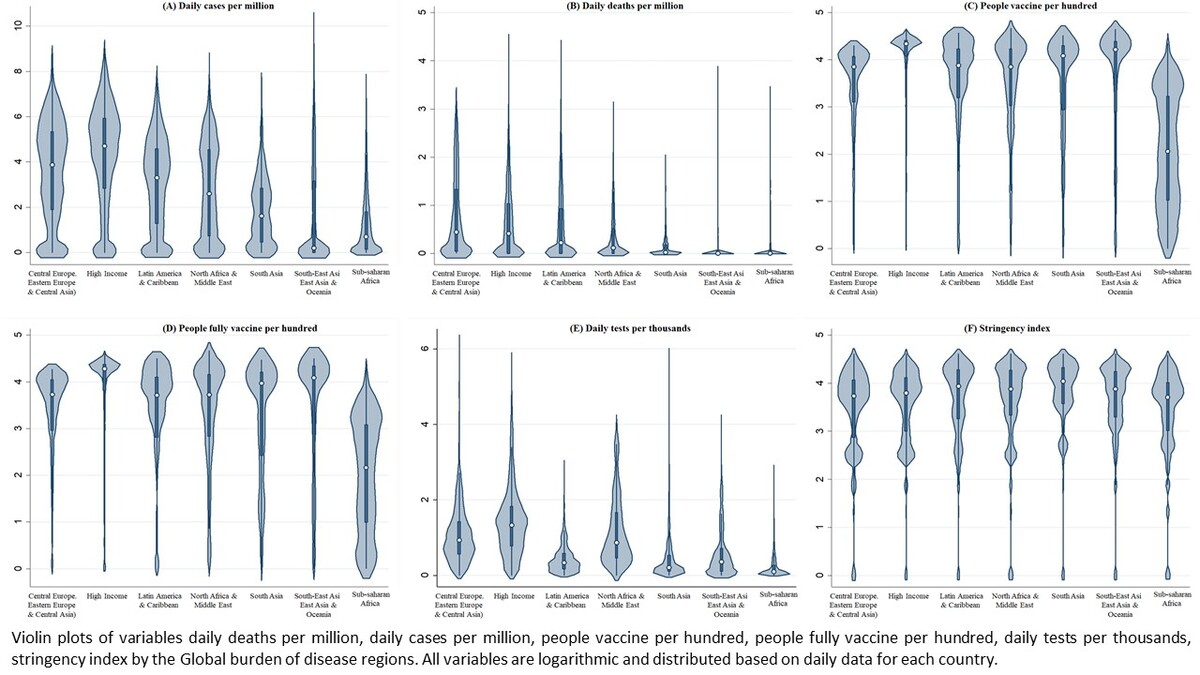Current issue
Archive
Manuscripts accepted
About the Journal
Editorial office
Editorial board
Section Editors
Abstracting and indexing
Subscription
Contact
Ethical standards and procedures
Most read articles
Instructions for authors
Article Processing Charge (APC)
Regulations of paying article processing charge (APC)
Editor's Choice
INFECTIOUS DISEASES / RESEARCH PAPER
The Role of Vaccination, Testing, and Public Restriction Policies in COVID-19 Mortality and Incidence: Insights from Global Burden of Disease Regions
1
Yonsei University Mirae Campus, Korea (South)
2
Yonsei University Wonju College of Medicine, Korea (South)
Submission date: 2024-03-25
Final revision date: 2024-07-15
Acceptance date: 2024-07-24
Online publication date: 2024-08-05
Corresponding author
KEYWORDS
TOPICS
ABSTRACT
Introduction:
This study aimed to examine the impacts of vaccination, testing, and government policies on COVID-19 mortality and incidence rates and compare these strategies' effectiveness by seven super regions of the Global Burden of Disease (GBD).
Material and methods:
This study used data from January 3, 2020, to March 29, 2023. The incidence and mortality indices were calculated using “daily cases” and “daily deaths” and selected as dependent variables. Vaccination, COVID-19 tests, strictness of a government's policy were explored using corresponding metrics.
Results:
Daily cases were four times higher in the high-income region (371.1) than those in the Latin America and the Caribbean region (98.3), but the mortality rate was similar (1.5). The number of vaccinated people did not consistently reduce the mortality across all GBD regions. However, full vaccination was associated with decreased mortality in all regions except Central, Eastern, and Southeastern Europe and Central Asia (CEEECA). Regarding daily testing, a favorable correlation was observed between daily deaths on a global scale, excluding Southeast Asia, East Asia, and Oceania. Overall, vaccination coverage and government policies were effective in reducing the COVID-19 mortality and incidence rates. However, only the high-income region showed a negative association between the stringency index to COVID-19 and incidence and mortality rates.
Conclusions:
Full vaccination significantly reduced COVID-19 mortality globally, except in the CEEECA region. HI regions showed lower incidence and mortality rates with stricter government measures. Effective vaccination programs and policies are crucial, emphasizing the need for strengthened international cooperation in future pandemics.
This study aimed to examine the impacts of vaccination, testing, and government policies on COVID-19 mortality and incidence rates and compare these strategies' effectiveness by seven super regions of the Global Burden of Disease (GBD).
Material and methods:
This study used data from January 3, 2020, to March 29, 2023. The incidence and mortality indices were calculated using “daily cases” and “daily deaths” and selected as dependent variables. Vaccination, COVID-19 tests, strictness of a government's policy were explored using corresponding metrics.
Results:
Daily cases were four times higher in the high-income region (371.1) than those in the Latin America and the Caribbean region (98.3), but the mortality rate was similar (1.5). The number of vaccinated people did not consistently reduce the mortality across all GBD regions. However, full vaccination was associated with decreased mortality in all regions except Central, Eastern, and Southeastern Europe and Central Asia (CEEECA). Regarding daily testing, a favorable correlation was observed between daily deaths on a global scale, excluding Southeast Asia, East Asia, and Oceania. Overall, vaccination coverage and government policies were effective in reducing the COVID-19 mortality and incidence rates. However, only the high-income region showed a negative association between the stringency index to COVID-19 and incidence and mortality rates.
Conclusions:
Full vaccination significantly reduced COVID-19 mortality globally, except in the CEEECA region. HI regions showed lower incidence and mortality rates with stricter government measures. Effective vaccination programs and policies are crucial, emphasizing the need for strengthened international cooperation in future pandemics.
Share
RELATED ARTICLE
We process personal data collected when visiting the website. The function of obtaining information about users and their behavior is carried out by voluntarily entered information in forms and saving cookies in end devices. Data, including cookies, are used to provide services, improve the user experience and to analyze the traffic in accordance with the Privacy policy. Data are also collected and processed by Google Analytics tool (more).
You can change cookies settings in your browser. Restricted use of cookies in the browser configuration may affect some functionalities of the website.
You can change cookies settings in your browser. Restricted use of cookies in the browser configuration may affect some functionalities of the website.



